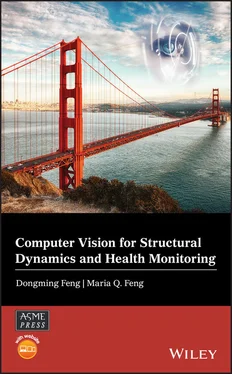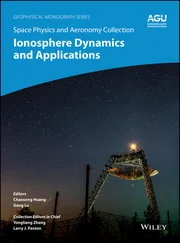1 Cover
2 Title Page Computer Vision for Structural Dynamics and Health Monitoring Dongming Feng Senior Engineer, Thornton Tomasetti NY, USA Maria Q. Feng Renwick Professor, Columbia University NY, USA This Work is a co‐publication between John Wiley & Sons Ltd and ASME Press
3 Copyright Page
4 List of Figures
5 List of Tables
6 Series Preface
7 Preface
8 About the Companion Website
9 1 Introduction1.1 Structural Health Monitoring: A Quick Review 1.2 Computer Vision Sensors for Structural Health Monitoring 1.3 Organization of the Book
10 2 Development of a Computer Vision Sensor for Structural Displacement Measurement 2.1 Vision Sensor System Hardware 2.2 Vision Sensor System Software: Template‐Matching Techniques 2.3 Coordinate Conversion and Scaling Factors 2.4 Representative Template Matching Algorithms 2.5 Summary
11 3 Performance Evaluation Through Laboratory and Field Tests 3.1 Seismic Shaking Table Test 3.2 Shaking Table Test of Frame Structure 1 3.3 Seismic Shaking Table Test of Frame Structure 2 3.4 Free Vibration Test of a Beam Structure 3.5 Field Test of a Pedestrian Bridge 3.6 Field Test of a Highway Bridge 3.7 Field Test of Two Railway Bridges 3.8 Remote Measurement of the Vincent Thomas Bridge 3.9 Remote Measurement of the Manhattan Bridge 3.10 Summary
12 4 Application in Modal Analysis, Model Updating, and Damage Detection 4.1 Experimental Modal Analysis 4.2 Model Updating as a Frequency‐Domain Optimization Problem 4.3 Damage Detection 4.4 Summary
13 5 Application in Model Updating of Railway Bridges under Trainloads 5.1 Field Measurement of Bridge Displacement under Trainloads 5.2 Formulation of the Finite Element Model 5.3 Sensitivity Analysis and Finite Element Model Updating 5.4 Dynamic Characteristics of Short‐Span Bridges under Trainloads 5.5 Summary
14 6 Application in Simultaneously Identifying Structural Parameters and Excitation Forces 6.1 Simultaneous Identification Using Vision‐Based Displacement Measurements 6.2 Numerical Example 6.3 Experimental Validation 6.4 Summary
15 7 Application in Estimating Cable Force 7.1 Vision Sensor for Estimating Cable Force 7.2 Implementation in the Hard Rock Stadium Renovation Project 7.3 Implementation in the Bronx‐Whitestone Bridge Suspender Replacement Project 7.4 Summary
16 8 Achievements, Challenges, and Opportunities 8.1 Capabilities of Vision‐Based Displacement Sensors: A Summary 8.2 Sources of Error in Vision‐Based Displacement Sensors 8.3 Vision‐Based Displacement Sensors for Structural Health Monitoring 8.4 Other Civil and Structural Engineering Applications 8.5 Future Research Directions
17 Appendix: Fundamentals of Digital Image Processing Using MATLABA.1 Digital Image Representation A.2 Noise Removal A.3 Edge Detection A.4 Discrete Fourier Transform
18 References
19 Index
20 End User License Agreement
1 Chapter 1 Table 1.1 Comparison of sensors for measuring structural vibrations.
2 Chapter 2 Table 2.1 Typical hardware components of a vision sensor system.
3 Chapter 3Table 3.1 Measurement errors of the vision sensor in shaking table tests.Table 3.2 Different levels of subpixel resolution.Table 3.3 Measurement errors: NRMSE (%).Table 3.4 Test conditions of eight representative measurements.Table 3.5 Errors between peak displacements measured by different sensors.
4 Chapter 4Table 4.1 Parameters of the three‐story frame structure.Table 4.2 Comparison of identified natural frequencies of the frame structure...Table 4.3 Parameters of the simply supported beam.Table 4.4 Comparison of identified natural frequencies of the beam structure.Table 4.5 Stiffness identification results (×10 4 N/m ).
5 Chapter 5Table 5.1 Design parameters of the bridge and track system.Table 5.2 Parameters of the freight train.Table 5.3 Dominant frequencies.
6 Chapter 6Table 6.1 Parameters for the numerical example.Table 6.2 Simulation cases.
7 Chapter 7Table 7.1 Cable length, measured cable frequencies, and tension discrepancies...Table 7.2 Cable geometric and material parameters.Table 7.3 Measured suspender rope frequencies and tension.
1 Chapter 1 Figure 1.1 Common displacement sensors: (a) LVDT; (b) laser vibrometer; (c) ... Figure 1.2 Vision‐based remote displacement sensor.
2 Chapter 2 Figure 2.1 Commercially available video cameras: (a) CMOS image sensor with ... Figure 2.2 Vision‐based multi‐camera measurement system. Figure 2.3 Time synchronization. Figure 2.4 Procedure for 2D vision sensor implementation.Figure 2.5 Defining a template subset in a source image.Figure 2.6 Surface plot of the NCC and template coordinates in image 1.Figure 2.7 Surface plot of the NCC and template coordinates in image 2.Figure 2.8 Schematic of stereo camera calibration.Figure 2.9 Scaling factor determination: (a) optical axis perpendicular to t...Figure 2.10 Error resulting from camera non‐perpendicularity: (a) effect of ...Figure 2.11 Flowchart of the UCC implementation.Figure 2.12 Orientation code ( N = 16).Figure 2.13 Matching results for images in ill conditions: (a) searching for...Figure 2.14 Bilinear interpolation for sub‐pixel analysis.Figure 2.15 Flowchart of vision sensor based on OCM.Figure 2.16 User interface of the OCM‐based displacement measurement softwar...
3 Chapter 3Figure 3.1 Shaking table test.Figure 3.2 Comparison of sinusoidal displacements by the LVDT and vision sen...Figure 3.3 Comparison of earthquake displacements by the LVDT and vision sen...Figure 3.4 Shaking table test of a three‐story frame structure: (a) shaking ...Figure 3.5 Subpixel resolution evaluation using a UCC‐based vision sensor: (...Figure 3.6 Comparison of displacements by OCM (artificial target), UCC (arti...Figure 3.7 Comparison of displacements by OCM (natural target), UCC (natural...Figure 3.8 Evaluation of robustness in unfavorable conditions.Figure 3.9 Case 1 comparison: (a) displacements by OCM and UCC; (b) UCC cros...Figure 3.10 Case 2 comparison: (a) displacements by OCM and UCC; (b) UCC cro...Figure 3.11 Case 3 comparison: (a) displacements by OCM and UCC; (b) UCC cro...Figure 3.12 Case 4 comparison: (a) displacements by OCM and UCC; (b) UCC cro...Figure 3.13 A steel building frame model on a seismic shaking table.Figure 3.14 Seismic shaking table setup.Figure 3.15 Experimental results of the seismic shaking table test: (a) meas...Figure 3.16 Test setup for the simply supported beam.Figure 3.17 Schematic of sensor placement.Figure 3.18 Case of a non‐perpendicular camera optical lens axis.Figure 3.19 Images of a marker panel for different camera tilt angles: (a) 3...Figure 3.20 Comparison of displacement measurement at point 16: (a) camera t...Figure 3.21 Field test: (a) Streicker Bridge; (b) artificial target.Figure 3.22 Randomly running pedestrians: displacement measurement by vision...Figure 3.23 Randomly running pedestrians: acceleration measurement: (a) meas...Figure 3.24 Jumping pedestrians: displacement measurement by vision sensor: ...Figure 3.25 Jumping pedestrians: acceleration measurement: (a) measured acce...Figure 3.26 Field test on a highway bridge.Figure 3.27 Experimental results of field tests on a highway bridge: (a) v =...Figure 3.28 View of the two testbed bridges.Figure 3.29 Field tests on the railway bridge: (a) setup of field tests; (b)...Figure 3.30 Target panel and existing features on the railway bridges: (a) H...Figure 3.31 Test H1: comparison of displacements by three sensors (day).Figure 3.32 Test H2: comparison of displacements by three sensors (day).Figure 3.33 Test H3: comparison of displacements by three sensors (day).Figure 3.34 Test H4: comparison of displacements by three sensors (day).
Читать дальше












